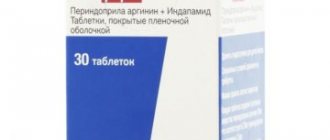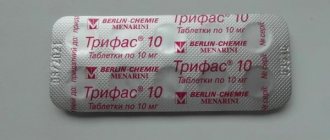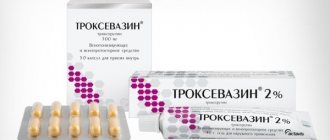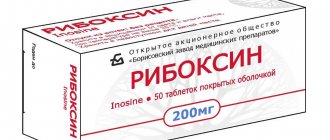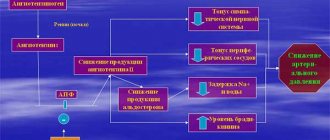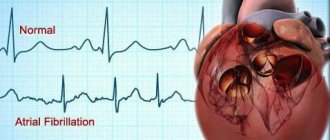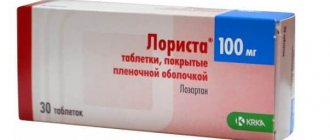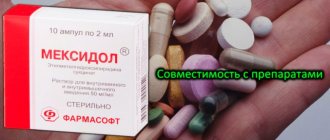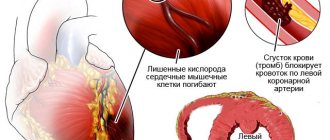Instructions for use Noliprel A
According to the generally accepted medical classification, the drug Noliprel A belongs to antihypertensive drugs with a complex of active substances. It is formed by the components of perindopril arginine and indapamide. Due to them, the medication has the ability to reduce systolic and diastolic pressure with a gradual accumulation of effect. After a month of treatment, the patient’s health stabilizes.
Compound
Three types of the drug are available, all of them are presented in tablet form. The composition and description of the products are shown in the table:
| Noliprel A | Noliprel A Forte | Noliprel A Bi-Forte | |
| Description | Film-coated white | ||
| Perindole concentration, mg per piece. | 2,5 | 5 | 10 |
| Indapamide concentration, mg per piece. | 0,625 | 1,25 | 2,5 |
| Compound | Sodium carboxymethyl starch, maltodextrin, lactose monohydrate, anhydrous colloidal silicon dioxide, magnesium stearate | ||
| Film casing | Magnesium stearate, glycerol, macrogol, titanium dioxide, hypromellose | ||
| Package | Bottles of 14, 29 or 30 pcs. | Bottles of 29 or 30 pcs. | |
Pharmacological properties
The drug Noliprel A is considered a combination drug; its pharmacological and pharmacokinetic properties depend on two components:
| Perindopril | Indapamide | |
| Mechanism of action | An inhibitor of the enzyme converting angiotensin 1 to angiotensin 2 (ACE inhibitor). Reduces the secretion of aldosterone, increases the activity of renin in the blood plasma, acts on the vessels of the muscles and kidneys. Does not develop reflex tachycardia, normalizes myocardial function, reduces tissue hypertrophy. | A substance from the sulfonamide group, similar in effect to thiazide diuretics. Inhibits the reabsorption of sodium ions, increases diuresis and reduces blood pressure. |
| Antihypertensive effect | Effective in the treatment of hypertension of any severity. Reaches maximum activity after 4-6 hours and maintains it throughout the day. | The effect is manifested when using a dose that has minimal diuretic effect. The activity is associated with an improvement in the elastic properties of large arteries. Does not affect lipid concentrations and carbohydrate metabolism. |
| Pharmacokinetics | Rapidly absorbed, bioavailability is 67%, 20% of the dose is converted into the active metabolite perindopril. Binds to plasma proteins by 30%, is excreted by the kidneys in 6-10 hours, penetrates the placental barrier. | It is quickly and completely absorbed, reaches maximum concentration after an hour, binds to proteins by 79%, and does not accumulate upon repeated administration. It is excreted within 28-48 hours by the kidneys and intestines. |
Indications for use
The instructions for use indicate that the drug Noliprel A is used for common (96%) essential hypertension to reduce blood pressure. The second indication for the use of the drug is the prevention of the development of microvascular complications in the kidneys in patients with arterial hypertension and type 2 diabetes mellitus, as well as macrovascular complications in cardiovascular diseases.
Pharmacological action of Noliprel
According to the instructions, Noliprel has an effect on the body, which is due to a combination of the individual properties of each of the components of this drug. The drug contains perindopril and indapamide. These components enhance each other's action.
The use of Noliprel gives a lasting clinical effect a month after the start of therapy. Moreover, if the patient stops taking Noliprel, this does not cause withdrawal syndrome.
According to the instructions, Noliprel can also have a vasodilating effect, helping to restore the elasticity of large arteries. At the same time, the drug reduces left ventricular hypertrophy.
Directions for use and dosage
Three forms of release of the drug Noliprel are used in different doses. The general rules for taking medications are to take them orally before meals, preferably in the morning. The medications are washed down with clean water. The course, regimen and frequency of use of each type of tablet depend on the individual characteristics of the patient and are prescribed by the attending physician according to indications.
Noliprel A tablets
Blood pressure medicine Noliprel A is prescribed as a tablet once a day. It is advisable to take only this drug, but if clinically necessary, it is allowed to combine it with combined complex treatment agents. To reduce the risk of developing complications from the cardiovascular system, 1 tablet is prescribed. once/day, after 3 months. the dose can be increased to 2 tablets. every day or a Forte tablet once a day.
Noliprel A Forte
Forte Noliprel tablets for blood pressure are taken orally before meals, one tablet once a day. If possible, dose selection begins with a single-component drug, and after monotherapy, if necessary, combination treatment is prescribed. To eliminate the risk of complications when treating patients with diabetes, the dose is one tablet/day and does not change throughout the entire duration of therapy.
Noliprel A Bi-forte
Like previous forms of drugs, Noliprel A Bi-forte is prescribed as a tablet once a day in the morning before meals. The medicine is prescribed based on systolic and diastolic blood pressure readings. For elderly patients, the dose is calculated based on age, body weight and gender. Dosage adjustment is also necessary for impaired renal function.
Duration of treatment
Typically, Noliprel is the main drug used to treat hypertension.
Taking pills for a long time is allowed, but it is advisable to take short breaks. Otherwise, the drug may negatively affect the functioning of the kidneys and liver.
How long to take Noliprel, the dose - all this should be decided by the doctor, taking into account the patient’s condition.
The drug is contraindicated in patients with severe renal failure. For moderately severe renal failure, the dosage should not be more than one tablet per day.
In some patients with impaired renal function while taking the drug, laboratory signs of failure of this organ appear. In this case, treatment is stopped. In the future, it is allowed to resume combination therapy, but in the lowest possible dosage and for a short course.
Long-term treatment with Noliprel is not recommended for the following diseases:
- angina pectoris;;
- scleroderma;
- hyperuricemia;
- diabetes;
- systemic lupus erythematosus;
- hypertrophic cardiomyopathy;
- aortic valve stenosis;
- chronic heart failure.
special instructions
Before using Noliprel A, you need to study the special instructions for taking the drug, located in the section of the same name in the instructions:
- use of the drug may cause hypokalemia, water-electrolyte imbalance, neutropenia, agranulocytosis, thrombocytopenia, hepatic encephalopathy, anemia, dry cough, jaundice, exacerbation of gout, photosensitivity;
- therapy is contraindicated in severe renal failure;
- if signs of renal failure appear, treatment is stopped;
- the composition contains lactose, so the drug cannot be prescribed for hereditary lactose and galactose intolerance, lactase deficiency and glucose-galactose malabsorption;
- in rare cases, treatment may be accompanied by increased sensitivity, the development of angioedema (if it affects the larynx, there is a risk of death due to suffocation, Epinephrine is required);
- while taking Noliprel against the background of desensitizing therapy and hemodialysis, anaphylactoid reactions may develop;
- the medication is prescribed with caution to elderly patients with atherosclerosis, renovascular hypertension, heart failure, diabetes mellitus, anemia after kidney transplantation, obstruction of the left ventricular outflow tract;
- general anesthesia significantly reduces blood pressure;
- indapamide gives a positive reaction in a blood test for doping control in athletes;
- the drug does not affect the ability to drive a car or reduce the speed of psychomotor reactions, but there are several cases with a decrease in concentration while taking the drug.
Tips for using Noliprel
In order for Noliprel to have the desired therapeutic effect and not cause harm to the body, it is necessary to take into account several nuances of its use. There are few of them, but they are very important.
The nuances of using Noliprel:
- Athletes should not take this drug before competitions. Otherwise, the test result for doping drugs may be false positive.
- The product does not affect a person’s ability to drive vehicles and complex machinery. However, some of its side effects can cause emergency situations. Therefore, when you start taking the medication, you must temporarily stop driving.
- It is necessary to take the product in the morning, at the same time. Otherwise, its effect will not be sufficiently pronounced.
- When taking Noliprel, you must regularly undergo blood and urine tests. This is necessary to control the level of electrolytes, fluids and salts in the body.
- Noliprel should not be combined with alcohol and drugs. In this case, there is a high probability of developing hypertension or hypotension. In addition, this combination increases the likelihood of side effects.
- When using this medication, you must drink enough fluid. Otherwise, dehydration may develop.
- It is also necessary to follow a diet when using Noliprel. You need to eat more foods rich in magnesium and potassium. It is also necessary to exclude fatty foods from the diet, as well as foods containing cholesterol. You cannot follow a salt-free diet when taking this remedy, but the amount of this flavor enhancer in your diet can be reduced.
During pregnancy
Doctors prohibit pregnant and nursing mothers from taking Noliprel A. When carrying a child, the drug can have fetotoxicity towards the fetus, in the second and third trimesters it can lead to impaired kidney development and ossification of the skull bones (ossification process involving calcium). Indapamide, when used in the 3rd trimester, can cause hypovolemia in women and ischemia in the fetus.
If pregnancy is planned or occurs during treatment with the drug, therapy is immediately canceled and another approved one is prescribed. When using the medicine during breastfeeding, the newborn may develop hypokalemia, kernicterus, and increased sensitivity to sulfonamide derivatives. Indapamide can reduce the amount of breast milk or even suppress lactation.
Video on the topic
This video discusses in detail the medicine for hypertension Noliprel. They tell who it is prescribed to and in what dosages:
Thus, one of the modern effective combined antihypertensive drugs is Noliprel. The drug gently but quickly stabilizes blood pressure. Available in different dosages. This makes it much easier to select the most appropriate dose. But you can’t self-medicate. A doctor should prescribe tablets and only after a complete examination of the patient.
The information on the MyMedNews.ru website is for reference and general information, collected from publicly available sources and cannot serve as a basis for making a decision on the use of medications in the course of treatment.
MyMedNews.ru
And we also have
Nexium or Emanera - which is better?
Drug interactions
Taking the drug Noliprel has permitted, permitted with caution and prohibited combinations with medications:
- Lithium preparations increase the concentration of lithium in plasma, leading to toxic effects;
- Baclofen, tricyclic antidepressants, neuroleptics, antihypertensive drugs, vasodilators, general anesthesia enhance the antihypertensive effect;
- non-steroidal anti-inflammatory drugs, including Acetylsalicylic acid, corticosteroids, Tetracosactide, sympathomimetics reduce the antihypertensive effect;
- double blockade leads to hyperkalemia, hypotensive effect and hyperkalemia;
- potassium-sparing diuretics, potassium preparations lead to an increase in the concentration of potassium in the blood serum, this threatens death;
- Estramustine, gliptins increase the risk of developing angioedema;
- Noliprel increases the hypoglycemic effect of insulin, oral sulfonylurea derivatives, and the toxicity of cardiac glycosides;
- Allopurinol, cytostatics, immunosuppressants, corticosteroids, Procainamide increase the risk of developing leukopenia;
- taking thiazide and loop diuretics leads to hypovolemia;
- Gold preparations lead to nitrite-like reactions.
Combination of Noliprel with other medications
Noliprel must be combined carefully with various medications and alcohol. After all, its compatibility with some substances is impossible. In this case, you can get negative effects from the treatment.
Compatibility of Noliprel with other substances:
| Drug groups | Possible effects of combination with Noliprel |
| Products containing lithium. | Possible lithium toxicity |
| Potassium-sparing diuretics. | Increased hypotensive effect of the drug. Acute hyperkalemia may develop. This combination is possible only if the patient has hypokalemia. |
| Erythromycin, Vincamine, Sultopride, Bepridil, Halofantrine. | Development of severe arrhythmia. |
| Insulin. | Hypokalemia may occur. |
| Antiarrhythmic medications. | Severe arrhythmia may develop. |
| Non-steroidal anti-inflammatory drugs. | Reducing the hypotensive ability of Noliprel. Increased likelihood of developing acute renal pathologies. |
| Tricyclic antidepressants and antipsychotics. | Strengthen the antihypertensive properties of the drug. Acute hypotension may occur. |
| Baclofen. | Synergistic combination. It is necessary to reconsider the dosage of Noliprel. |
| Glucocorticosteroids, laxatives, mineralocorticoids, amphotericin, tetracosactides. | Reducing the hypotensive effect of Noliprel. Hypokalemia may develop. |
| Cardiac glycosides. | Increased toxicity of cardiac glycosides. Hypokalemia is likely to develop. |
| Metformin. | Formation of lactic acidosis. |
| Products with iodine. | Dehydration and renal failure may occur. It is very important to control fluid levels in the body. |
| Potassium salts. | Hypercalcemia. |
| Cyclosporine. | Increased creatinine levels in the blood. |
Some of these combinations are only possible in special cases, as they increase the likelihood of developing serious side effects. The need for such combinations should be determined by a physician.
Side effects
When taking pills, the patient sometimes experiences the following side effects from different systems. It can be:
- anemia, paresthesia, pain syndromes, asthenia;
- dizziness, vertigo, sleep disturbance, confusion;
- fainting, blurred vision, tinnitus, bradycardia;
- the drug can cause arrhythmia, myocardial infarction;
- dry cough, shortness of breath, bronchospasm, pneumonia, rhinitis;
- sometimes the intake is accompanied by tachycardia, angina pectoris,
- dry mouth, nausea, abdominal and epigastric pain;
- vomiting, dyspepsia, constipation, loss of appetite, taste disturbance, diarrhea;
- jaundice, hepatitis, pancreatitis, skin rash;
- itching, purpura, erythema, necrolysis, photosensitivity, allergic reactions;
- muscle spasms, kidney failure, impotence, increased sweating.
Adverse reactions, overdose
When taking these tablets for the first time, you must refrain from driving vehicles and complex mechanisms. It is prohibited to take alcohol during treatment; this combination can lead to disruption of the blood supply to tissues and organs.
Taking pills may cause hypersensitivity, an allergic reaction, or Quincke's edema.
The drug is contraindicated for:
- impaired renal and liver function;
- hypercalcemia;
- hypokalemia;
- chronic insufficiency of the adrenal cortex.
The use of the medicine during pregnancy or lactation is prohibited. The drug should be replaced with a safer one. The active substances penetrate into breast milk and the bloodstream of the fetus.
The medication is not intended for the treatment of pediatric patients.
After use, adverse reactions may occur. They are:
- deterioration of kidney function;
- increased hypotension, arrhythmia, heart attack, stroke;
- pain, bloating, constipation, vomiting;
- headaches, loss of appetite, slight lethargy;
- difficulty breathing, cough.
Despite the fact that taking the drug is determined by medical indications, the drug "Noliprel" also has side effects
An overdose of a drug causes:
- drowsiness;
- hypotension;
- bradycardia;
- convulsions;
- chills;
- nausea, vomiting;
- dizziness, sometimes loss of consciousness.
Contraindications
Groups of patients with diseases or characteristics of the body have contraindications to taking the medication. These include:
- hypersensitivity to components;
- angioedema in history or hereditary;
- severe renal or liver failure (reduced creatinine clearance);
- hypokalemia;
- bilateral renal artery stenosis or only one functioning kidney;
- pregnancy, lactation, age under 18 years.
Overdose
Exceeding the dose of the drug may lead to:
- dizziness;
- a sharp drop in blood pressure;
- convulsions;
- vomiting;
- confusion.
A patient who has exceeded the dosage urgently needs first aid until the ambulance arrives. To do this, it is necessary to implement measures to accelerate the elimination of the drug: gastric lavage, taking sorbents and ensuring oxygen access.
Analogs
There are synonyms and substitutes for Noliprel on the market. The first includes drugs with the same active ingredients, the second - with the same antihypertensive effect. Direct and indirect analogues of the drug are:
- Co-Prenessa;
- Perindopril;
- Prestarium;
- Prilamide;
- Erupnil;
- Accusid;
- Ampril;
- Euroramipril;
- Mypril;
- Prevencor;
- Ramag;
- Ramazid.
Mechanism of action
The effect of noliprel on blood pressure is based on the combination of an ACE inhibitor (preventing the synthesis of substances that increase blood pressure - angiotensin l and ll, and reducing the level of the hormone - aldesterone) and a diuretic, which removes excess water from the body. The complex Perindopril + Indapamide is the basis of Noliprel. In addition to them, the medicine contains additional components and preservatives: magnesium stearate, cellulose, lactose, silicon dioxide, etc.
Price
You can buy Noliprel tablets in pharmacies or online stores. Their cost differs depending on the type of medicine, the number of pieces in the package and the trade markup. Approximate prices are shown in the table:
| Name, number of tablets | Price on the Internet, in rubles | Pharmacy cost, in rubles |
| Noliprel A 30 pcs. | 598 | 610 |
| Noliprel A Forte 30 pcs. | 695 | 715 |
| Noliprel A Bi-forte 30 pcs. | 740 | 755 |
Composition and indications for use
Noliprel is a drug with combined effects, since it contains two active substances at once. It is their combination that gives a powerful hypotensive effect:
- indapamide . It is a diuretic, that is, it removes excess fluid through the kidneys;
- perindopril . Has a vasodilating effect.
Therefore, the drug is used to lower blood pressure (diastolic and systolic), unless it is caused by other diseases. It is also prescribed for hypertension in patients with type 2 diabetes.
Side effects
Side effects caused by the action of perindopril:
- Urinary system: rarely - proteinuria, increased creatinine in urine, decreased renal function; extremely rarely - acute renal failure.
- Cardiovascular system: often – orthostatic hypotension, excessive decrease in blood pressure; extremely rarely - arrhythmia, angina pectoris, myocardial infarction, stroke.
- Nervous system: often - increased fatigue, headache, dizziness, asthenia, mood lability, ringing in the ears, blurred vision, convulsions, sleep disturbance, taste disturbance, anorexia, paresthesia; extremely rarely - confusion.
- Digestive system: often - constipation, diarrhea, nausea, vomiting, abdominal pain; rarely – dryness of the oral mucosa; extremely rarely - pancreatitis, cholestatic jaundice, hyperbilirubinemia, increased activity of liver enzymes.
- Respiratory system: often – dry cough; rarely – difficulty breathing, bronchospasm; extremely rarely - rhinorrhea.
- Hematopoietic system: often – anemia (in patients after hemodialysis or kidney transplantation); rarely – thrombocytopenia, hypohemoglobinemia, decreased hematocrit; extremely rarely - hemolytic anemia, pancytopenia, agranulocytosis.
- Water and electrolyte balance: increased potassium concentration, decreased sodium level; extremely rarely - increased calcium levels.
- Allergic reactions: often – skin itching and rashes; rarely – angioedema, urticaria; extremely rarely - erythema multiforme.
- Other: rarely - decreased potency, increased sweating.
Adverse reactions from the use of the drug, provoked by the action of indapamide:
- Digestive system: rarely - dry mouth, constipation, nausea; extremely rarely - pancreatitis, hepatic encephalopathy (with liver failure).
- Central and peripheral nervous system: rarely - asthenia, headache, dizziness, paresthesia.
- Hematopoietic system: extremely rare - leukopenia, thrombocytopenia, agranulocytosis, hemolytic anemia, aplastic anemia, bone marrow aplasia.
- Metabolism: rarely - an increase in the concentration of glucose and urea in the blood plasma.
- Water and electrolyte balance: rarely - decreased sodium levels (body dehydration, hypovolemia, orthostatic arterial hypotension), hypokalemia, compensatory metabolic alkalosis; extremely rarely - increased calcium concentration.
- Dermatological reactions: rarely - skin rashes, exacerbation of systemic lupus erythematosus, hemorrhagic vasculitis.
- Allergic reactions: skin manifestations (in patients predisposed to allergies).
